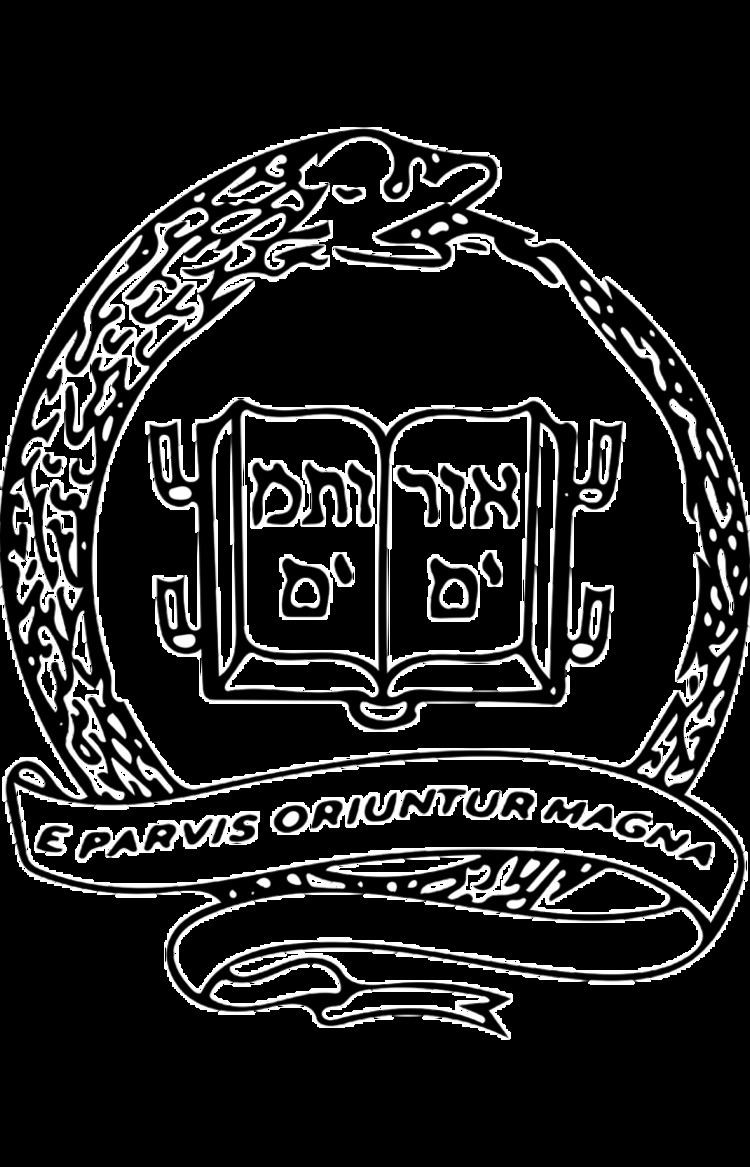Formation 1768 Location Yale University | Legal status Active Region New Haven, Connecticut | |
 | ||
Motto E parvis oriuntur magna | ||
Brothers in Unity is a four-year secret society at Yale University. It used to be a debating society.
Contents
Founding
The Society of Brothers in Unity at Yale College was founded by 21 members of the Yale classes of 1768, 1769, 1770 and 1771. The founders included David Humphreys, who is noted in the society's public 1841 catalogue as the "cornerstone" of the founding class. The society was founded chiefly to combat existing class separation among literary societies; prior to 1768, Yale freshman were not "received into any Society," and Junior society members were forced into the servitude of seniors "under dread of the severest penalties." Humphreys, a freshman of the class of 1771, persuaded two members of the Senior class, three Junior class members, two Sophomores, and 14 freshman to support the society's founding.
Early activity
Immediately after its conception, the society's unorthodox class composition was allegedly challenged by other literary groups at Yale College. According to its catalogue, Brothers in Unity only became an independent institution after persevering "an incessant war" waged by multiple traditional societies who did not support the concept of a four-year debating community. It is speculated that this struggle initiated the Brothers' near 250-year rivalry with Linonia, which previously did not initiate freshman members. Within a year, however, Brothers in Unity became fully independent, its popularity influencing other societies to reconsider their exclusion of first year students. The Yale College freshman class of 1771 yielded 15 members of Brothers in Unity, while Linonia accepted four; the first noted point in which underclassmen were publicly accepted into a Yale society. The Brothers adopted the motto E parvis oriuntur magna between 1768 and 1769.
1768-1841
Between its founding and 1841, the society is said to have followed the template of other debating societies, although operating under "Masonic secrecy," according to 19th century Yale historian Ebenezer Baldwin. In conjunction with Linonia and the Calliopean Society, Brothers in Unity was noted by Baldwin to discuss "scientific questions" and gravitate towards "literary pursuits." This is substantiated by the Brother's own public documentation, which denotes that the society sought "lofty places in science, literature, and oratory" fields, as well as general "intellectual improvement."
The Brotherhood, between the years of 1768 and 1841, claims membership of 15 Supreme Court Justices (seven of which Chief Justices), 6 United States Governors, 13 Senators, 45 Congressional representatives, 14 presidents of colleges and universities, two United States Attorney Generals, and a United States Vice President. In its catalogue, the Brotherhood also asserts: "Every President of the United States, with the exception of two, has had in his cabinet one of our members, and the governor's chair of our own state has been filled for twenty years with Brothers in Unity." 26 Yale valedictorians after the position's 1798 founding are attributed to the Society.
Membership to the Brothers and the Linonian Society divided the students of Yale College beginning in the turn of the 19th century. Both held expansive literary collections, which they used to compete against each other. Between 1780 and 1841, the Brothers claimed right to more volumes than Linonia, although these assertions are disputed The two societies' rivalry extended to their membership. Brothers in Unity claims membership of John C. Calhoun, who was alphabetically assigned to Linonia, but had "undiminished attachment" to the Brothers. However, while publications released by both societies repeatedly assert superiority amongst each other, they also express positive sentiment; denoting each other as "ornaments" of Yale and "generous rivals."
At the time of the formation of Yale's central library, Linonia and 'Brothers in Unity donated their respective libraries to the university. The donation is commemorated in the Linonia and Brothers Reading Room of Yale's Sterling Memorial Library. The reading room contains the Linonia and Brothers (L&B) collection, a travel collection, a collection devoted to medieval history, and a selection of new books recently added to Sterling’s collections.
Actions as a secret society
Following the transformation of Yale's debating societies into the Yale Union, and later, the Yale Political Union, Brothers in Unity and the Linonian Society ceased function as literary and debating societies. Both societies continued their existence in secrecy, recanting their roles as intellectual colloquiums and instead prioritizing power and social influence as paramount. Linonia morphed into the template of other Yale secret societies, although its current existence is still questioned and its membership is not disclosed to the public as of 2012. While unsubstantiated, Linonia is said to participate in Yale's April "tap night," along with the college's senior societies.
Unlike Linonia, Brothers in Unity refrained from association with the customs of Yale's senior societies. The society is rumored to tap a small cohort of members from each class during the fall semester, a notion in line with the organization's 1768 constitution and 1841 catalogue. Internally, the society is referenced as the "Brotherhood," a community stressing unilateral action amongst members to acquire power in the realms of business, politics, and philanthropy. The society is said to have implemented methods of deterrence stemming from its 1768 constitution that prevent brothers from unearthing the identities of fellow members or disclosing internal actions of the brotherhood. However, public knowledge of specific traditions, discussions, and society regulations of Brothers in Unity ended after its 19th-century turn to secrecy, rendering most modern rumor as conjecture.
Though the society no longer discloses the names of its members, its presence on campus continued through the 19th and 20th centuries, with reported activity spanning into the turn of the 21st century. It is unknown whether men exclusively fill current membership of the Brothers, due to the integration of women into Yale's societal web.
Note
Note: The society's last public catalogue of members was published in 1841. Since the transition of Brothers in Unity into a fully secretive society, the names of members during the 20th and 21st century are unknown.
